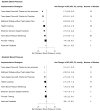Comparative Effectiveness of Implementation Strategies for Blood Pressure Control in Hypertensive Patients: A Systematic Review and Meta-analysis
- PMID: 29277852
- PMCID: PMC5788021
- DOI: 10.7326/M17-1805
Comparative Effectiveness of Implementation Strategies for Blood Pressure Control in Hypertensive Patients: A Systematic Review and Meta-analysis
Abstract
Background: The prevalence of hypertension is high and is increasing worldwide, whereas the proportion of controlled hypertension is low.
Purpose: To assess the comparative effectiveness of 8 implementation strategies for blood pressure (BP) control in adults with hypertension.
Data sources: Systematic searches of MEDLINE and Embase from inception to September 2017 with no language restrictions, supplemented with manual reference searches.
Study selection: Randomized controlled trials lasting at least 6 months comparing the effect of implementation strategies versus usual care on BP reduction in adults with hypertension.
Data extraction: Two investigators independently extracted data and assessed study quality.
Data synthesis: A total of 121 comparisons from 100 articles with 55 920 hypertensive patients were included. Multilevel, multicomponent strategies were most effective for systolic BP reduction, including team-based care with medication titration by a nonphysician (-7.1 mm Hg [95% CI, -8.9 to -5.2 mm Hg]), team-based care with medication titration by a physician (-6.2 mm Hg [CI, -8.1 to -4.2 mm Hg]), and multilevel strategies without team-based care (-5.0 mm Hg [CI, -8.0 to -2.0 mm Hg]). Patient-level strategies resulted in systolic BP changes of -3.9 mm Hg (CI, -5.4 to -2.3 mm Hg) for health coaching and -2.7 mm Hg (CI, -3.6 to -1.7 mm Hg) for home BP monitoring. Similar trends were seen for diastolic BP reduction.
Limitation: Sparse data from low- and middle-income countries; few trials of some implementation strategies, such as provider training; and possible publication bias.
Conclusion: Multilevel, multicomponent strategies, followed by patient-level strategies, are most effective for BP control in patients with hypertension and should be used to improve hypertension control.
Primary funding source: National Institutes of Health.
Figures


Comment in
-
Blood Pressure Control: Missed Opportunity or Potential Holy Grail?Ann Intern Med. 2018 Jan 16;168(2):147-148. doi: 10.7326/M17-3036. Epub 2017 Dec 26. Ann Intern Med. 2018. PMID: 29277851 No abstract available.
-
Review: Multilevel and patient-level implementation strategies reduce BP more than usual care in hypertension.Ann Intern Med. 2018 Mar 20;168(6):JC29. doi: 10.7326/ACPJC-2018-168-6-029. Ann Intern Med. 2018. PMID: 29554667 No abstract available.
References
-
- Forouzanfar MH, Liu P, Roth GA, et al. Global burden of hypertension and systolic blood pressure of at least 110 to 115 mm Hg, 1990–2015. JAMA. 2017;317:165–82. - PubMed
-
- Gay HC, Rao SG, Vaccarino V, Ali MK. Effects of different dietary interventions on blood pressure: systematic review and meta-analysis of randomized controlled trials. Hypertension. 2016;67:733–9. - PubMed
-
- Ettehad D, Emdin CA, Kiran A, et al. Blood pressure lowering for prevention of cardiovascular disease and death: a systematic review and meta-analysis. Lancet. 2016;387:957–67. - PubMed
Publication types
MeSH terms
Substances
Grants and funding
LinkOut - more resources
Full Text Sources
Other Literature Sources
Medical
